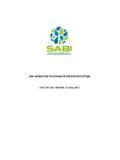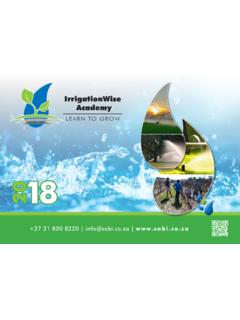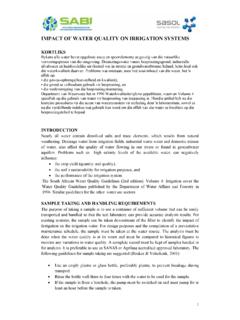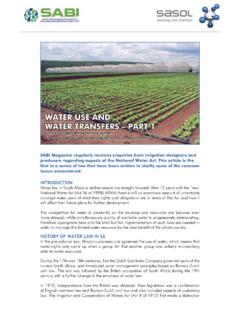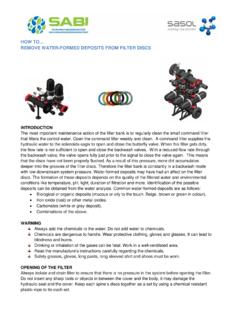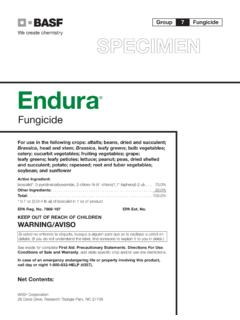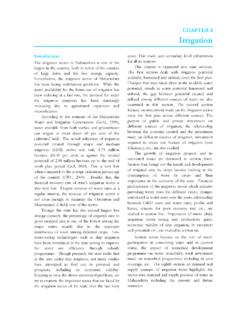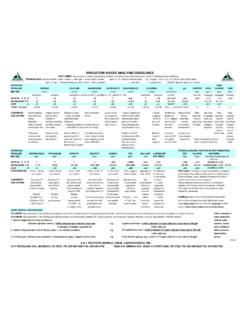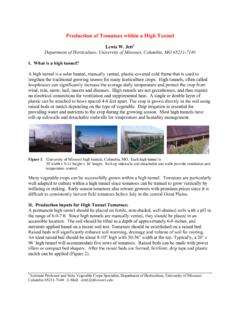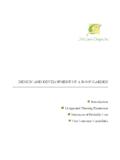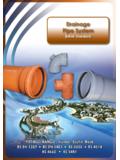Transcription of NORMS FOR THE DESIGN OF IRRIGATION SYSTEMS
1 NORMS FOR THE DESIGN OF IRRIGATION SYSTEMS DATE OF LAST REVIEW: 11 March 20142 Table of Contents Background .. 5 1. system Planning .. 6 Suitability of IRRIGATION SYSTEMS .. 6 Allowable depletion levels of soil water .. 9 Percentage wetted area .. 9 system Efficiency .. 10 IRRIGATION hours per 11 Surveying and mapping .. 11 Recommended contour intervals and scales of maps .. 11 Use of GPS SYSTEMS .. 11 2. IRRIGATION SYSTEMS .. 13 Micro sprinkler IRRIGATION .. 13 Minimum gross application rate .. 13 Distribution Uniformity .. 13 Flow velocity in laterals .. 13 Drip IRRIGATION .. 13 Distribution Uniformity .. 13 Flow velocity in laterals required for effective flushing .. 14 Flushing of laterals.
2 14 Flow velocity in manifolds .. 14 Specific management SYSTEMS .. 14 Sprinkler IRRIGATION .. 15 Sprinkler selection .. 15 Sprinkler spacing .. 15 Minimum gross application rate .. 15 Maximum pressure variation .. 15 Centre Pivot .. 16 Maximum IRRIGATION time vs. soil infiltration rate .. 16 Christiansen uniformity coefficient (CU) .. 16 Friction through centre pivot .. 16 Effective radius of end gun .. 16 Travelling irrigators .. 16 3 Pressure variation over the length of the travelling path .. 16 Speed variation .. 16 Site .. 16 Flow rate .. 16 Sprinkler choice .. 16 Strip width .. 17 Flood IRRIGATION .. 17 Slope of beds .. 17 Allowable flow depth in beds .. 17 Allowable soil infiltration rate per bed.
3 17 3. Water supply SYSTEMS .. 17 Pipe friction in main and sub main lines .. 17 Valves .. 18 Filters .. 18 Disc and mesh filters .. 18 Sand Filters .. 18 DESIGN pump capacity (safety factor for wear and tear) .. 19 Allowable velocity in the suction pipe .. 20 Pump efficiency .. 20 Maximum motor power output .. 20 Motor efficiency .. 20 Variable speed drives (VSDs) .. 21 General .. 21 Totally Enclosed Fan Cooled Motors (TEFC) Motors .. 21 Submersible motors .. 21 Electrical supply and connection .. 22 4. Greenhouses and Tunnels .. 23 Crop water requirement (mm/day) .. 23 Overhead IRRIGATION .. 23 Drip IRRIGATION .. 23 Pipelines, Pumps and Accessories .. 23 Installation of drainage pipes .. 24 Allowable ground slopes in greenhouses.
4 24 4 DISCLAIMER: Although the NORMS have been compiled with great care, SABI, its employees or representatives shall not under any circumstances be held responsible for any loss or damage to any person, object or organisation as a result of the application of these NORMS . 5 Background A norm is defined as a widely accepted or required standard against which performance or achievement can be assessed. The SABI DESIGN NORMS serve to guide the designer in calculations and decision making in the planning and DESIGN of agricultural IRRIGATION SYSTEMS . The NORMS are presented under the following four main headings: system planning IRRIGATION SYSTEMS Water supply SYSTEMS Greenhouses and tunnels The DESIGN of IRRIGATION SYSTEMS requires a balanced approach that results in both technically, financially and ethically acceptable solutions for the customer.
5 Diverging from the NORMS is acceptable if it can be well motivated from both a technical and an ethical perspective by the designer. 6 1. system Planning Suitability of IRRIGATION SYSTEMS When selecting the type of IRRIGATION system to be used in a specific situation, there are a number of factors that have to be taken into consideration. Although it is not possible to set fixed NORMS for the selection of IRRIGATION SYSTEMS , it is recommended that information regarding the following five aspects of the situation that the system is being designed for, should be collected and assessed: Crop: information should be collected on the cultivar, planting and harvesting date / growing season, row direction and spacing of plants, crop heights, tilling practices, climatic water requirements and any climate control requirements.
6 Soil: an investigation of soil and analysis and interpretation of the data by a soil scientist is recommended. Factors such as texture, structure, infiltration rate, water holding capacity, soil depth and permeability should be taken into consideration, as well as crop specific requirements such as wetted leaves, dry leaves and stems, root development Water: both aspects of quantity and quality should be investigated. A hydrological study and confirmation from the water management authority are recommended to ensure adequate water is lawfully available. The water quality should be suitable for both the crop and soil of the specific situation, and may also require special treatment if a detrimental effect on the IRRIGATION equipment is expected. Climate: the closest weather station should be identified in order to access long term historical weather data such as evaporation, rainfall, temperature, humidity and wind, as these will have an influence on the water requirements and system orientation.
7 Site: the size, shape and slope of the site available should be taken into consideration when selecting the IRRIGATION system . Table 1 has been compiled by the ARC IAE to assist designers with the selection of the most appropriate type of IRRIGATION system (Burger et al, 2003). The following symbols are used in the table to indicate the degree of limitation or obstacles that might occur: o No limitation x Little limitation xx Moderate limitation xxx Severe # Requires further thorough investigation by an expert. 7 Table 1 Comparison between SYSTEMS Criteria Flood Sprinkler Micro spray Drip Big gun / traveling irrigator Centre pivot and linear move 1. Climate Temperature > 30 C o xx xx o xx xx Relative humidity < 40% o xx xx o xx xx Wind speed > 15 km/h o xxx xxx o xxx xxx Rainfall < 300 mm/year o o o xx o O 2.
8 Topography Earthworks > 250 m3/ha xx o o o o O 3. Salinity Salinity > 2 000 ppm x xx xx xxx xx xx 4. Flow rate < 100 m3/h xx o o o x xx 5. Water quality Turbidity (silt, fine sand) o x xx xxx x x Lime, iron o x xx xxx x x Algae o o xx xxx o o 6. Soils > 20% clay x x xx xx xx xxx 8 Criteria Flood Sprinkler Micro spray Drip Big gun / traveling irrigator Centre pivot and linear move 10 20% clay xooox x < 5% clay xx o o xx o o < 600 mm deep xxx x x x x x 600 1200 mm deep xx o o o o o 7. Initial infiltration rate of soil < 20 mm/h x xx xx x xx # > 150 mm/h xxx o o o o o 8. Crops Nursery xxx x o o xx x Row crops x o xx x x x Bed crops x o xx xx x x Field crops o o xxx xxx o o Orchards, vineyards x x o x xx xx Fungal diseases o xx xx o xx xx Ablution of chemicals o xx x o xx xx 9.
9 Operation Managerial inputs xx xx xx xxx xx x 9 Criteria Flood Sprinkler Micro spray Drip Big gun / traveling irrigator Centre pivot and linear move Labour xxxxoox o Energy requirements o xx xx xx xxx xx Water use xxx xx xx x xx xx Application of chemicals # xx x x xx xxx Allowable depletion levels of soil water The following allowable depletion values are recommended to be used during the planning process to determine the size of the soil water reservoir and IRRIGATION cycle length. These values are aimed at maintaining the maximum evapotranspiration rates of crops which were grouped according to water stress sensitivity (Annandale & Steyn, 2008). Table 2 Allowable depletion values as a percentage of the available water in the active root zone Crop group Allowable depletion (% of available water) to maintain the following ET rates (mm/day) 2 mm 3mm 4 mm 5 mm 6 mm 7 mm 8 mm 9 mm 10 mm 1 50 43 353025232020 182 68 58 48 40 35 33 28 25 23 3 80 70 60 50 45 43 38 35 30 4 88 80 706055504543 40 Crop group 1: Onions, peppers, potatoes Crop group 2: Bananas, cabbage, peas, tomatoes Crop group 3: Lucern, beans, citrus, groundnuts, pineapples, sunflowers, watermelons, wheat Crop group 4.
10 Cotton, sorghum, olives, grapes, maize, soybeans, sugar beet, tobacco Percentage wetted area The values for the percentage of area that an IRRIGATION system wets (W), that can be used during the planning process are displayed in Table 3. The values are based on data from FAO Publication nr 56 (Allen et al, 1998). In the case of drip IRRIGATION , the lateral movement of water in the soil can be assessed with an on site trial, and in the case of micro sprinklers, the wetted diameter of the specific sprinkler can be obtained from a manufacturer s catalogue to get a more accurate value. 10 Table 3 Percentage wetted area Type of water application W, % Rain, Snow Overhead SYSTEMS (Sprinklers, Centre Pivot, Linear, Traveling gun, Rotating boom) Drip Micro sprinkler Flood IRRIGATION (basins and beds) Flood IRRIGATION (narrow furrows) Flood IRRIGATION (wide furrows) Flood IRRIGATION (alternative furrows) 100100 30 40 40 80 80 100 60 100 40 60 30 50 system Efficiency Table 4 shows the recommended and minimum values for the efficiency of different types of IRRIGATION SYSTEMS based on the results of a WRC project (Reinders, 2010), and is determined by a water balance approach.

